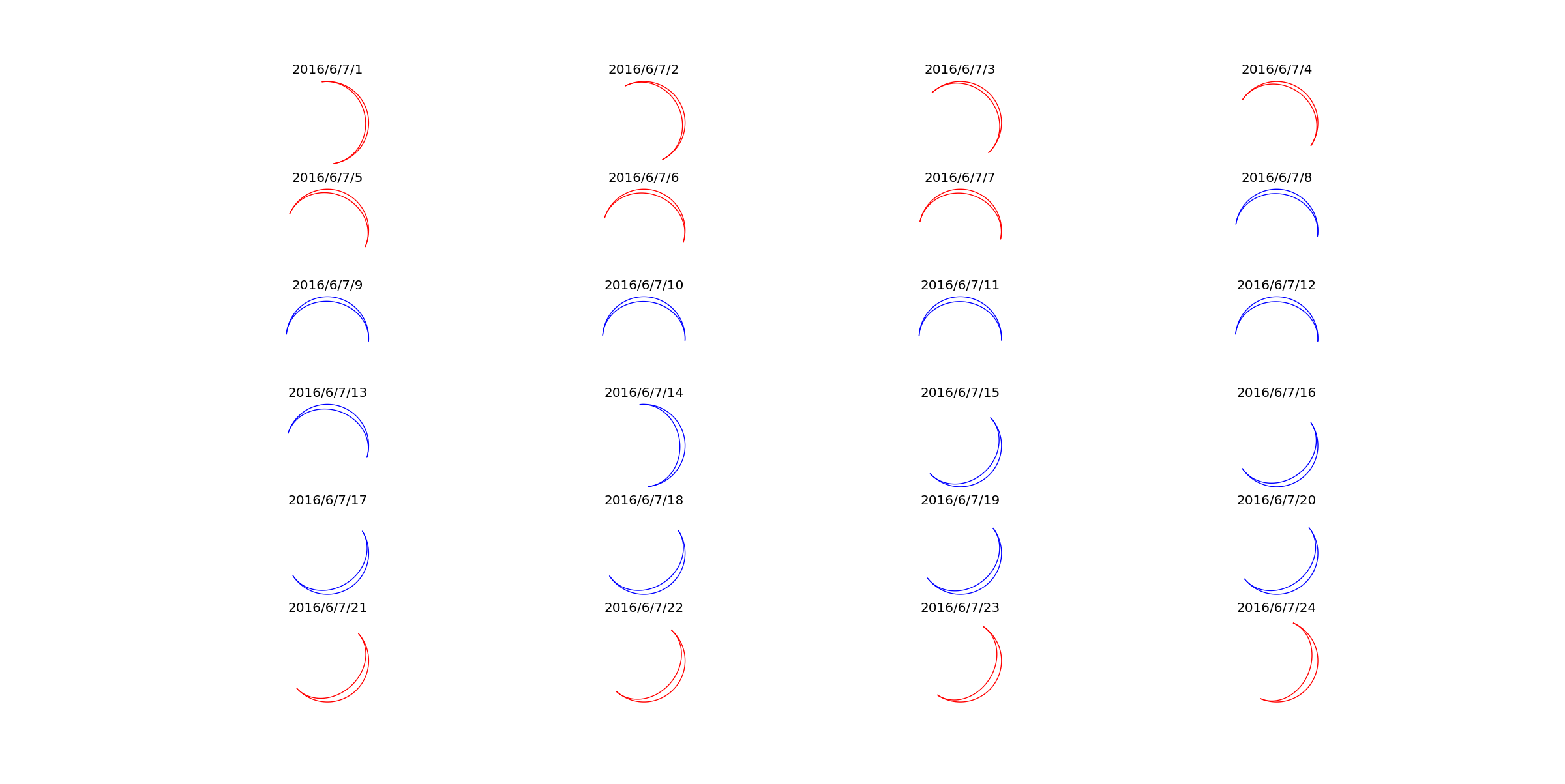月相
在中央氣象局月相圖,我們可以查到每一天的月相資料, 舉凡新月、滿月、上弦月、下弦月等的日子,一目了然。
新月前後三四天,只有10%左右的部分是亮的,亮的部分在右側?左側?右上角?右下角?左上角?左下角?事實上,同一天的不同時刻看,亮的位置是會改變的,前述網站沒有呈現這個現象。
基本上,月亮的形狀主要由地球、月亮、太陽的相關位置以及觀察地點所決定。月亮面對太陽的半個球是亮的,面對地球的半個球是我們(地表觀察者)可以看到的,兩者的交集就是我們看到的部分。至於哪一個角落是亮的,因為地球的自轉,觀察者的天頂方向會隨時間改變,也就是視覺上的上方會隨時間改變,造成視覺上亮的部位改變。
在地平坐標系統下,只要有太陽與月亮的位置資料,我們就可以算出月相。
下面的圖形是用附錄中的程式製作出來的。它是2016年6月3日(陰曆4月28)每一整點在台北可以看到的月相。圖中的月形,藍色代表在地平面上,紅色代表在地平面下,可以明顯看到月相隨間改變的情形。

下面的圖形是2016年6月7日(陰曆5月初三)每一整點在台北可以看到的月相。

地平坐標系統
地平坐標系統以觀察地為原點,觀測目標的位置用距離(\(\rho\))、仰角(\(\phi\))、方位角(\(\theta\))來定位,這是球體坐標。距離指的是觀測站到目標的距離,仰角指的是觀測目標的方向與地面的夾角。方位角指的觀測目標的東西南北方位,以北方為基準,向東轉的角度就是。換句話說,北方的方位角為0度,東方為90度,南方為180度,西方為270度。
將東方、北方、天頂方向分別訂為直角座標系統下的X、Y、Z軸的方向,\((x,y,z)\)為目標的直角座標。直角坐標\((x,y,z)\)與球體坐標\((\rho,\theta,\phi)\)的關係如下: \[x=\rho\cos\phi\sin\theta, y=\rho\cos\phi\cos\theta, z=\sin\phi\]
月球上的臨時座標系統
月球的方位角用\(\theta\)表示、仰角用\(\phi\)表示,則地面望向月亮的方向\(e_2=(\cos\phi\sin\theta,\cos\phi\cos\theta,\sin\phi)\)。從月球位置出發,沿著同一方位角的大圓,往天頂的方向\(e_3\)就是\(e_2\)對\(\phi\)的微分, 也就是\(e_3=(-\sin\phi\sin\theta,-\sin\phi\cos\theta,\cos\phi)\)。令\(e_1=e_2\times e_3\), 從地表往月亮看,\(e_1\)的方向是月亮的右邊,\(e_3\)的方向是月亮的上邊,\(e_2\)的方向是月亮的後邊。以月亮中心為原點,\(\{e_1,e_2,e_3\}\)為坐標軸方向,我們建立一個臨時坐標系統。
令矩陣\(M\)的第一列為\(e_1\),第二列為\(e_2\),第三列為\(e_3\)。在地平坐標系統下,月球到太陽的方向向量坐標用\(S_e\)表示, 則在臨時坐標系統中,月球到太陽的方向向量坐標為\(S_m=M S_e\)。另一方面,在臨時坐標系統中,月球望向地球的方向向量為\((0,-1,0)\)。
在臨時坐標系統中,以月亮的半徑為單位,面向我們的半個月球以大圓\(C_1: x^2+z^2=1, z=0\)為邊界,\(C_1\) 的參數式為\((\cos\theta,0,\sin\theta)\)。
面向太陽的半個月亮的邊界\(C_2\)也是一個大圓,\(C_2\)就是過圓點且與\(S_m\) 垂直的平面\(E\) 跟單位球面相交的部分。令\(B_0=S_m\times (0,1,0)\),\(B_1\)是與\(B_0\)同向的單位向量,\(B_2=S_m\times B_1\)。 如此,\(B_1,B_2\)是平面\(E\)上兩個互相垂直的單位向量,而 \(C_2\)的參數式為\(\cos\theta\cdot B_1+\sin\theta\cdot B_2\)。
\(C_1,C_2\)兩大圓相交,互相切割,得到4段圓弧,屬於\(C_1\)的兩段用\(C_{11},C_{12}\)表示,屬於\(C_2\)的兩段用\(C_{21},C_{22}\)表示。從\(C_{11},C_{12}\)中挑出靠近太陽的一段(與\(S_m\)的內積大於0),從\(C_{21},C_{22}\)挑出靠近地球的一段(第二個坐標小於0),所得兩段圓弧圍得月球表面的部分是月亮中亮的部分。這兩段圓弧在臨時坐標系統中\(XZ\)平面的垂直投影,所圍成的區域就是視覺上的月相。
附錄中,利用python平台的套件ephem與matplotlib,我們製作函數 moonshape_t(lon,lat,tz,year,month,day,hour)來顯示月相。參數lon為經度,東經為正;lat為緯度,北緯為正,tz為時區(以小時為單位,台北為+8),year為西元,hour採24小時制,可以有小數。 執行moonshape_t('121.537','25.017',8,2016,6,3,16.5),我們就可得到,2016年6月3日下午4點半在台北(東經121.537度, 北緯25.017度)所看到的月相。
附錄
import ephem
import math
import numpy as np
import matplotlib.pyplot as plt
def spher2cart(theta,phi):
return np.array([math.cos(phi)*math.sin(theta),math.cos(phi)*math.cos(theta),math.sin(phi)])
def spher2cartDphi(theta,phi):
return np.array([-math.sin(phi)*math.sin(theta),-math.sin(phi)*math.cos(theta),math.cos(phi)])
def greatCircleWithPar(N):
# [0,1.0,0] 為觀察者望向月球的方向
# N 為月球望向太陽的方向
# 通過月球球心與N垂直的平面切割月球的大圓C,C可以用cos(theta)*b1+sin(theta)*b2表示,
# 其中的b1,b2是C平面上兩個互相垂直的單位向量
b1=np.cross(N,np.array([0,1.0,0]))
if np.linalg.norm(b1)>0.000001:
b1=1/np.linalg.norm(b1)*b1
b2=np.cross(N,b1)
else:
b1=np.array([1.,0,0])
b2=np.array([0,0,1.])
#print([b1,b2])
def fun(theta):
return math.cos(theta)*b1+math.sin(theta)*b2
return fun
def cutarc(points):
arcs=[]
arc=[]
for i in range(len(points)):
if arc==[]:
arc.append(points[i])
else:
if np.linalg.norm(points[i]-arc[-1])<0.1:
arc.append(points[i])
else:
arcs.append(arc)
arc=[points[i]]
arcs.append(arc)
return arcs
def moonshape_t(lon,lat,tz,year,month,day,hour,show=True):
date=ephem.Date((year,month,day,hour-tz)) # GMT+8
site=ephem.Observer()
site.date=date
site.lon=lon
site.lat=lat
sun=ephem.Sun(site)
moon=ephem.Moon(site)
# e2 望向月亮的方向
e2=spher2cart(moon.az,moon.alt)
# e3 月亮在天球上的往上方向
e3=spher2cartDphi(moon.az,moon.alt)
# e1 月亮在天球上的往右方向
e1=np.cross(e2,e3)
M=np.stack([e1,e2,e3])
moon2sun=sun.earth_distance*spher2cart(sun.az,sun.alt)-moon.earth_distance*spher2cart(moon.az,moon.alt)
s_e=1/np.linalg.norm(moon2sun)*moon2sun
# s_m: 以 {e1,e2,e3} 為坐標軸方向,月亮為原點時,太陽的方向
s_m=M.dot(s_e)
if moon.alt>0:
color='b'
else:
color='r'
print(['moon.alt',moon.alt,'moon.az',moon.az])
f=greatCircleWithPar(s_m)
thetas=np.linspace(-math.pi,math.pi,num=200)
plt.plot([math.cos(theta) for theta in thetas],[math.sin(theta) for theta in thetas],'w-')
points=[f(theta) for theta in thetas if f(theta)[1]<0]
arcs=cutarc(points)
for arc in arcs:
plt.plot([x[0] for x in arc],[x[2] for x in arc],color+'-')
points=[np.array([math.cos(theta),0.0,math.sin(theta)]) for theta in thetas
if np.dot(np.array([math.cos(theta),0.0,math.sin(theta)]),s_m)>0]
arcs=cutarc(points)
for arc in arcs:
plt.plot([x[0] for x in arc],[x[2] for x in arc],color+'-')
plt.axis('off')
plt.axis('equal')
plt.title(str(year)+'/'+str(month)+'/'+str(day)+'/'+str(hour))
if show:
plt.show()
lon='121.537'
lat='25.017'
tz=8
moonshape_t(lon,lat,tz,2016,6,3,16)
for i in range(1,25):
plt.subplot(6,4,i)
moonshape_t(lon,lat,tz,2016,6,3,i,False)
plt.show()